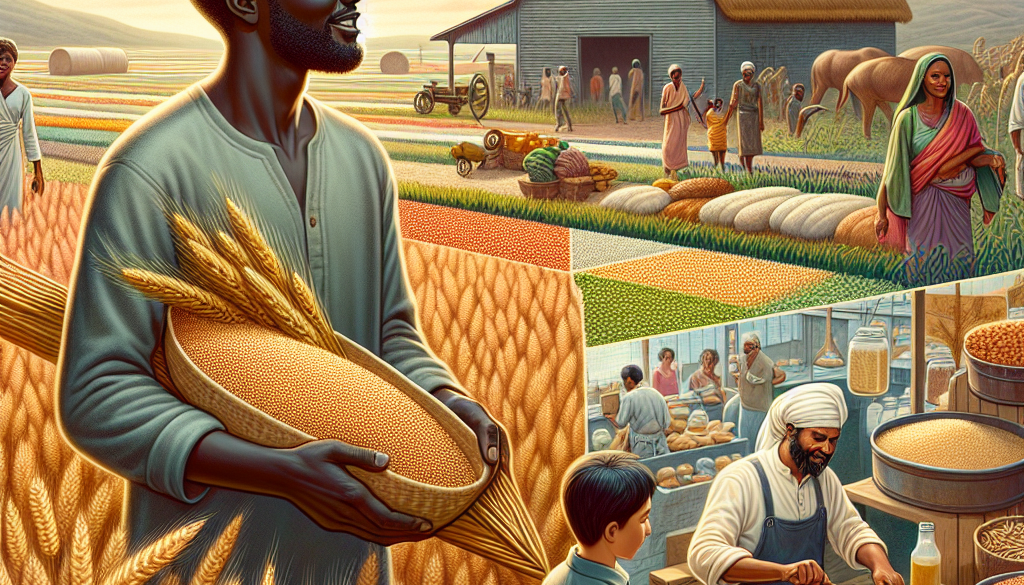Whole Grain Usage: Ancient Grains’ Resurgence
-
Table of Contents
- Whole Grain Usage: The Resurgence of Ancient Grains
- The Nutritional Powerhouse of Ancient Grains
- Environmental Sustainability and Ancient Grains
- The Cultural and Culinary Renaissance
- Case Studies and Statistics: The Growth of Ancient Grains
- Challenges and Considerations
- Conclusion: Embracing the Ancient Grain Movement
- Discover the Benefits of ETprotein’s Plant-Based Proteins
Whole Grain Usage: The Resurgence of Ancient Grains

In recent years, there has been a significant shift in consumer preferences towards healthier and more sustainable food options. This change has led to the resurgence of ancient grains in modern diets. Ancient grains, which include a variety of whole grains that have been largely unchanged over the last several hundred years, are gaining popularity due to their nutritional benefits and versatility in cooking. This article explores the reasons behind this resurgence and the impact it has on our health and the environment.
The Nutritional Powerhouse of Ancient Grains
Ancient grains are revered for their high nutritional value. They are typically rich in dietary fiber, vitamins, minerals, and antioxidants, and are often a good source of protein. Unlike refined grains, which have been stripped of valuable nutrients during processing, whole ancient grains retain their germ, bran, and endosperm, providing a complete nutritional package.
- Quinoa, for instance, is a complete protein containing all nine essential amino acids.
- Amaranth is known for its high levels of magnesium and iron.
- Teff is packed with calcium and resistant starch, which is beneficial for gut health.
These grains not only contribute to a balanced diet but also help in managing weight, reducing the risk of chronic diseases, and improving overall health.
Environmental Sustainability and Ancient Grains
Ancient grains are often praised for their sustainability. Many of these grains are adapted to harsh climates and poor soil conditions, making them resilient to changes in the environment. This hardiness reduces the need for chemical fertilizers and pesticides, which can be harmful to the ecosystem.
- Millet and sorghum, for example, are drought-tolerant and can thrive in arid regions.
- Barley and spelt require less water and fertilization compared to more common grains like wheat.
By incorporating ancient grains into agricultural systems, farmers can promote biodiversity, conserve water, and reduce the carbon footprint associated with farming.
The Cultural and Culinary Renaissance
Ancient grains are deeply rooted in various cultures around the world. As people become more interested in global cuisines and the stories behind their food, these grains are making a comeback in the culinary scene.
- In the Mediterranean, farro has been a staple for centuries and is now featured in modern salads and soups.
- In South America, quinoa has been a vital part of the diet for thousands of years and is now used globally in a variety of dishes.
Chefs and home cooks alike are experimenting with ancient grains to add unique flavors and textures to their recipes, further driving their popularity.
Case Studies and Statistics: The Growth of Ancient Grains
The market for ancient grains has seen substantial growth in recent years. According to a report by MarketsandMarkets, the global ancient grain market is projected to reach USD 4.8 billion by 2025, growing at a CAGR of 5.8% from 2020 to 2025. This growth is attributed to the increasing demand for healthier and more diverse food products.
- A study by the Whole Grains Council found that 31% of Americans are trying to increase their consumption of whole grains, with ancient grains being a significant part of this trend.
- Product launches featuring ancient grains have doubled over the past five years, indicating a strong consumer interest.
These statistics highlight the growing appeal of ancient grains and their potential to shape the future of the food industry.
Challenges and Considerations
Despite their many benefits, there are challenges to the widespread adoption of ancient grains. One of the main issues is the lack of familiarity among consumers, which can lead to hesitation in trying new foods. Additionally, ancient grains can be more expensive than their conventional counterparts due to lower yields and higher production costs.
Education and awareness campaigns, along with efforts to improve the scalability of ancient grain production, can help overcome these barriers and make these nutritious grains more accessible to a broader audience.
Conclusion: Embracing the Ancient Grain Movement
The resurgence of ancient grains is a positive trend that benefits both our health and the environment. By choosing these nutrient-dense and sustainable options, consumers can enjoy a diverse range of flavors while supporting agricultural practices that are kinder to the planet. As the demand for ancient grains continues to grow, we can expect to see more innovation and variety in the ways these grains are incorporated into our diets.
Discover the Benefits of ETprotein’s Plant-Based Proteins
For those looking to complement their whole grain intake with high-quality plant proteins, ETprotein offers a range of organic and allergen-free products. Their selection includes organic rice protein, pea protein, and various seed proteins, which are perfect for enhancing the nutritional profile of meals and snacks. Whether you’re formulating new food products or seeking to boost your personal health regimen, ETprotein’s plant proteins are an excellent choice.
About ETprotein:
ETprotein, a reputable plant protein vegan protein Chinese factory manufacturer and supplier, is renowned for producing, stocking, exporting, and delivering the highest quality organic bulk vegan protein and plant proteins. They include Organic rice protein, clear rice protein, pea protein, clear pea protein, watermelon seed protein, pumpkin seed protein, sunflower seed protein, mung bean protein, peanut protein etc. Their offerings, characterized by a neutral taste, non-GMO, allergen-free attributes, cater to a diverse range of industries. They serve nutraceutical, pharmaceutical, cosmeceutical, veterinary, as well as food and beverage finished product distributors, traders, and manufacturers across Europe, USA, Canada, Australia, Thailand, Japan, Korea, Brazil, and Chile, among others.
ETprotein specialization includes exporting and delivering tailor-made protein powder and finished nutritional supplements. Their extensive product range covers sectors like Food and Beverage, Sports Nutrition, Weight Management, Dietary Supplements, Health and Wellness Products, and Infant Formula, ensuring comprehensive solutions to meet all your protein needs.
As a trusted company by leading global food and beverage brands and Fortune 500 companies, ETprotein reinforces China’s reputation in the global arena. For more information or to sample their products, please contact them and email sales(at)ETprotein.com today.












